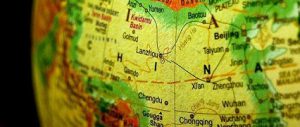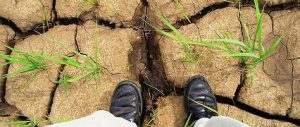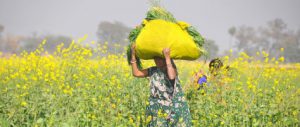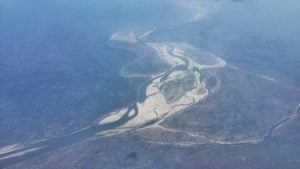As the UN-led Earth Summit in Rio de Janeiro draws closer, sustainability experts are mobilising to set out new ideas and models for a greener future.
One approach growing in popularity among academics and NGOs is the concept of planetary boundaries, formulated by Swedish scientist Johan Rockström and colleagues in 2009. You can read a detailed account of this approach in "Our bounded world", also published today. But, in short, Rockström identifies nine “earth system processes”, which have boundaries humanity must stay within to avoid catastrophic environmental change.
The processes are: climate change; biodiversity loss; excess nitrogen and phosphorus production; stratospheric ozone depletion; ocean acidification; global consumption of freshwater; change in land use for agriculture; air pollution; and chemical pollution.
So far, humanity is failing in key areas. We are losing biodiversity at enormous pace – 100 to 1,000 times faster than the natural rate; we emit far too much carbon dioxide; and we remove almost 100 million tonnes more nitrogen from the atmosphere per year than is acceptable.
Drawing on this concept, senior researcher at Oxfam Kate Raworth has come up with a new framework, which also takes human welfare into account. The “doughnut” combines planetary boundaries with social boundaries and, says Raworth, shows it is possible to lift millions out of poverty at the same time as protecting the planet. I asked her to explain.
Irina Fedorenko: What is the story behind the doughnut? Why have you decided to draw on the planetary boundaries concept?
Kate Raworth: I find the concept of nine planetary boundaries really compelling because it is simple to understand and visually clear: it makes Earth-system science accessible to non-scientists, and that’s powerful.
But if there is a ceiling of resource use, beyond which lies unacceptable environmental degradation, so too is there a foundation of resource use, below which lies human deprivation. If we are to talk of natural resource constraints and the need to live within planetary boundaries, then we also have to talk about the fundamentals of global resource distribution, and the need to ensure that we also live within social boundaries.
The doughnut is the space between the two – where every person has the resources needed for a fulfilling life, but collectively humanity lives within the means of this one planet.
IF: Scientists warn that the planet is already under stress, while campaigners fight to raise living standards for the world’s poor. How do you reconcile these apparently competing pressures?
KR: One of the good news insights of the doughnut is that getting all seven billion people alive today above the social foundation need not be a source of pressure on planetary boundaries. Ending hunger for the 13% of people who are undernourished would require around 3% of the world’s current food supply – a fraction of what is lost and wasted in the food chain each year.
Likewise, ending energy poverty for the 19% of people who have no access to electricity could be achieved for as little as a 1% increase in global carbon dioxide emissions. Currently, half of the world’s carbon emissions are produced by just 11% of the global population. So the message is clear: it is wealth and extreme inequality – not ending poverty – that is putting this planet under pressure.
The doughnut concept. Source: www.oxfam.org.uk
IF: Is the doughnut equally applicable to developed and developing countries? What are the implications for countries as different as China and the United Kingdom?
KR: The ambition of bringing all people above the social foundation while remaining within planetary boundaries has to be a global one, and it clearly requires global cooperation. We will only succeed if we collectively achieve far greater equity in global resource use, within and between countries, and also far greater efficiency in transforming those resources in order to meet human needs.
I think the doughnut shows that the developed-developing country distinction is past its sell-by date because, when it comes to pursuing social justice and environmental sustainability together, we are all developing.
In low-income countries, where many people live in poverty, the primary focus has to be on getting everyone above the social foundation – but without getting locked long-term into resource-intensive infrastructure, such as expensive fossil fuel imports.
High-income countries have a clear responsibility to lead first and fastest in decoupling their economic development from resource use. The major emerging economies are demonstrating some of the most dynamic transitions to development pathways that could bring humanity between the boundaries. And the precedent they set will be hugely influential in determining the future pathways open to today’s low-income countries.
IF: Were there any concerns the doughnut concept wouldn’t be taken seriously?
KR: Some people initially responded by saying that planetary boundaries are objective and scientifically certain, whereas social boundaries are subjective and impossible to define. In fact I’d say it’s easier to argue the reverse. Our understanding of planetary boundaries is in its infancy.
Just as doctors started to analyse the limits of the human body centuries ago – investigating how fast the heart can beat before we collapse, how long we can survive without water, how much food we need to avoid malnutrition – so today’s Earth-system scientists are acting as ecological doctors, starting to analyse the limits of planet Earth. There are huge areas of uncertainty, including ethical choices to be made about risk. So setting planetary boundaries is in many ways a new and subjective enterprise.
Defining social boundaries is also subjective, but attempts to do it started over 60 years ago, with the Universal Declaration of Human Rights. Consensus around that has developed through international human rights law, while UN agencies have collected data about people living in unacceptable deprivation for decades.
There is in fact much in common at the heart of these two concepts, and I think that this is partly why the idea of bringing them together has been so well received.
IF: Now you are taking the doughnut to Rio. What kind of outcome do you expect and what’s next?
KR: I think that the interest in the doughnut around Rio+20 is partly because it shows in one picture how the three pillars of sustainable development – social, environmental and economic – are interdependent, and partly because the doughnut doesn’t tell us all the answers, so it works from many perspectives.
The central message of the doughnut is that we can only pursue environmental sustainability if we pursue far greater social equity at the same time, within and between countries. If we talk of planetary boundaries, then we must talk of social boundaries too, along with all the distributional implications that it brings. If the doughnut can help to convey these messages, to broaden concepts of what economic development means, or help define a vision for sustainable and equitable development in the 21st century, this would be a huge achievement.
What’s next? Oxfam is working with others to produce national-level analyses of planetary and social boundaries in several countries, to see whether this way of looking at a nation’s needs and resources can help stimulate national debates about alternative development pathways, about and what a vision for equitable and sustainable development looks like.
It will be fascinating to see if and how this concept can be put to work in national policy debates.
Irina Fedorenko is an intern at chinadialogue.
For more information on the doughnut concept, see Oxfam’s introduction here. Oxfam will also be hosting a public debate on planetary and social boundaries at the IIED Fair Ideas Conference in Rio on June 17.
This article is published here as part of Nuclear Enery and Developement Programme, which is supported by the Heinrich-Boell Foundation.
Homepage image by AlexPears



